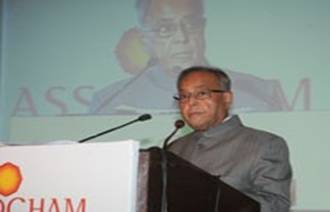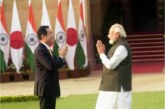By FGR Bureau
Finance Minister Pranab Mukherjee said today the banking sector faces a huge challenge of financial inclusion with the trillion dollar Indian economy racing ahead on a high growth curve.
“Financial inclusion is a major challenge before the banking sector and financial system at large. At the same time, it offers huge opportunities for the national economy to grow at a rate of 9 to 9.5 per cent during the 12th Five Year Plan,” he said while addressing ASSOCHAM’s National Banking Conclave titled ‘Challenges and Opportunities in a Trillion Dollar Economy.’
Mr. Mukherjee said the government is deepening policy reforms, considering further liberalizing foreign direct investment policy and addressing gaps in overall economic regulatory architecture so that banking services reach rural areas. “Newer perspectives and strategies towards financial inclusion are needed to reach un-banked and the under-banked sections of our country.”
He said the Reserve Bank of India is in the process of issuing additional banking licenses to private sector players. Major steps are being taken to simplify and place administrative procedures concerning taxation, trade transfers on electronic interface – free of discretion and bureaucratic delays. This will set the tone for a newer, vibrant and more efficient economy, said the finance minister. A sound and resilient banking sector, well functioning financial markets, robust liquidity management along with payment and settlement infrastructure are seen as pre-requisites for financial stability.
“Consolidation of banking services, consistently meeting the capital adequacy requirements, leveraging advanced technology, effectively managing human resources with a focus on pro-active leadership and re-skilling of human resources are emerging as major areas of concern of Indian banks that need to be addressed,” said Mr. Mukherjee. Meanwhile, Mr. Dilip Modi, president of The Associated Chambers of Commerce and Industry of India (ASSOCHAM), said financial services revenue from rural areas across the country could be 12 to 13 billion dollars by 2015.
The opportunity presented by growing asset base is however confronted with several challenges, the most formidable being implementation of a time-bound financial inclusion strategy. “We must synergize financial inclusion with digital inclusion to ensure faster and cost-effective delivery of products and services.” He appreciated government efforts to regulate the micro-finance sector and ensure greater transparency while providing small ticket size loans to rural population at affordable interest rates.
Chamber’s senior vice-president R.N. Dhoot said the Indian economy is poised to grow to a size of three trillion dollars and become the third largest worldwide by 2020. Banks will play a major role in the process by meeting capital requirements of all sectors of the economy.
ASSOCHAM secretary general D.S. Rawat said India has the second highest number of financially excluded households in the world. About 40 per cent of the country’s population has bank accounts and only 10 per cent have any kind of life insurance cover while a meager 0.6 per cent has non-life insurance cover.
Others present on the occasion were RBI’s deputy governor K.C. Chakraborty, member at the Planning Commission Narendra Jadhav, joint secretary (capital markets) at the finance ministry Thomas Mathew, vigilance commissioner J.M. Garg, chairperson of ASSOCHAM’s national council for banking and finance M. Narendra, chairman and managing director of Indian Bank T.M. Bhasin, executive director of Vijaya Bank Subhalakshmi Panse, executive director of Bank of India N. Seshadri, and national leader and partner at Ernst & Young’s global financial services division Ashvin Parekh. (ASSOCHAM)



